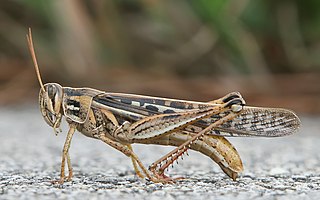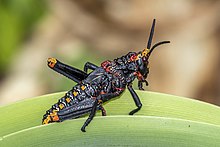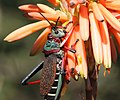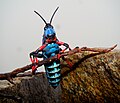
The Pentatomoidea are a superfamily of insects in the suborder Heteroptera of the order Hemiptera. As hemipterans, they possess a common arrangement of sucking mouthparts. The roughly 7000 species under Pentatomoidea are divided into 21 families. Among these are the stink bugs and shield bugs, jewel bugs, giant shield bugs, and burrower bugs.

Grasshoppers are a group of insects belonging to the suborder Caelifera. They are amongst what are possibly the most ancient living groups of chewing herbivorous insects, dating back to the early Triassic around 250 million years ago.

Dactylis is a genus of Eurasian and North African plants in the bluegrass subfamily within the grass family. Dactylis is native to North Africa, they are found throughout the world, and are an invasive species. They are known in English as cock's-foot or cocksfoot grasses, also sometimes as orchard grasses.

The banded bullfrog is a species of frog in the narrow-mouthed frog family Microhylidae. Native to Southeast Asia, it is also known as the Asian painted frog, digging frog, Malaysian bullfrog, common Asian frog, and painted balloon frog. In the pet trade, it is sometimes called the chubby frog. Adults measure 5.4 to 7.5 cm and have a dark brown back with stripes that vary from copper-brown to salmon pink.
The notum is the dorsal portion of an insect's thoracic segment, or the dorsal surface of the body of nudibranch gastropods. The word "notum" is always applied to dorsal structures; in other words structures that are part of the back of an animal, as opposed to being part of the animal's ventral surface, or underside.

Romalea is a genus of grasshoppers native to the Southeastern and South-central United States. As traditionally defined, it contains a single species, Romalea microptera, known commonly as the Georgia Thumper,eastern lubber grasshopper, Florida lubber, or Florida lubber grasshopper, although some recent authorities regard Taeniopoda as a junior synonym, in which case there are about a dozen Romalea species in southern United States, Mexico and Central America.

Autohaemorrhaging, or reflex bleeding, is the action of animals deliberately ejecting blood from their bodies. Autohaemorrhaging has been observed as occurring in two variations. In the first form, blood is squirted toward a predator. The blood of these animals usually contains toxic compounds, making the behaviour an effective chemical defence mechanism. In the second form, blood is not squirted, but is slowly emitted from the animal's body. This form appears to serve a deterrent effect, and is used by animals whose blood does not seem to be toxic. Most animals that autohaemorrhage are insects, but some reptiles also display this behaviour.

Phymateus viridipes, also known as the green milkweed locust or African bush grasshopper, is an African locust in the family Pyrgomorphidae.

Pyrgomorphidae is a family of grasshoppers in the order Orthoptera; it is the only family in the superfamily Pyrgomorphoidea. Pyrgomorphidae is found worldwide in tropical and warm temperate regions, but the vast majority of the family's approximately 500 species are from Africa, Asia and Australia. Their name is probably derived from pyrgos meaning "tower": a reference to the form (morph) of the head in the type genus Pyrgomorpha and other genera.

Taeniopoda eques, the western horse lubber grasshopper, is a relatively large grasshopper species of the family Romaleidae found in arid and semi-arid parts of southwestern United States to central and southwestern Mexico. Most populations are identifiable by their shiny black bodies with contrasting yellow markings, but some adults are mostly yellowish, orangish or greenish. The species is unique in using its black coloration to thermoregulate and in being chemically defended. The aposematic coloration warns vertebrate predators of its unpalatability and allows the grasshopper to roost conspicuously upon shrubs.

Petasida ephippigera, the Leichhardt's grasshopper, is a relatively large, brightly coloured pyrgomorph species of grasshopper in the monotypic genus Petasida, native to the Top End region of tropical northern Australia.

Phymateus is a genus of fairly large grasshoppers of the family Pyrgomorphidae, native to shrubland, semi-deserts, savanna, woodland, gardens and cultivated areas in Sub-Saharan Africa, with ten species in the African mainland and two species in Madagascar. Some species have bright aposematic colours and are highly toxic.

Poekilocerus pictus, the painted grasshopper, aak grasshopper or ak grasshopper, is a fairly large and brightly coloured species of grasshopper found in India, Pakistan and Afghanistan, especially in drier regions. Both adults and nymphs are toxic; the nymphs are notorious for being able to squirt a jet of noxious liquid at up to around 30 cm (1 ft) away when grasped.

Aularches miliaris is a grasshopper species of the monotypic genus Aularches, belonging to the family Pyrgomorphidae. A native of South and Southeast Asia, the bright warning colours of this fairly large grasshopper keep away predators and their defense when disturbed includes the ejection of a toxic foam.
Cornops aquaticum is a semiaquatic species of grasshopper native to the Neotropics, from southern Mexico south to central Argentina and Uruguay. It feeds and breeds exclusively on members of the aquatic plant family Pontederiaceae, especially water hyacinth, and is being investigated as a possible biological pest control agent for the water hyacinth in countries where that plant is invasive.

Zonocerus is a genus of grasshoppers (Caelifera) in the family Pyrgomorphidae and the tribe Phymateini. The two species are found in Africa, with Z. elegans found in central, eastern and southern regions, including Madagascar, and Z. variegatus found in western regions. Both species are significant agricultural pests, especially for African smallholder farmers. Both adults and nymphs have relatively bright, aposematic colours, and adults typically are about 3–5 cm (1.2–2.0 in) long.

Poekilocerus is a genus of grasshoppers in the family Pyrgomorphidae and the monotypic tribe Poekilocerini. Species are found in the northern half of Africa, and in Southwest and South Asia, often in arid or semi-arid areas.

Dictyophorus griseus is a species of grasshopper in the family Pyrgomorphidae, the gaudy grasshoppers, native to tropical Africa. Adults are typically about 5–6.5 cm (2.0–2.6 in) long.

Tropidacris cristata, the giant red-winged grasshopper, is a widespread species of lubber grasshopper in the family Romaleidae from tropical South and Central America, and Mexico. It is among the largest grasshoppers in the world by length and wingspan, reaching up to 14.5 cm (5.7 in) and 24 cm (9.4 in) respectively. More typical adult lengths are 5.5–7 cm (2.2–2.8 in), average 6.5 cm (2.6 in), in males and 7–12 cm (2.8–4.7 in), average 11 cm (4.3 in), in females. As suggested by the common name, adult T. cristata have conspicuously red wings in flight, although the exact red hue varies. The flightless and gregarious nymphs have aposematic dark-and-yellow stripes and are presumed to be toxic.

Dictyophorus is the type genus of grasshoppers in the tribe Dictyophorini, of the family Pyrgomorphidae; it is native to sub-Saharan Africa. The genus was named by Carl Peter Thunberg in 1815. They are relatively large, typically about 4–7 cm (1.6–2.8 in) long, and often have bright colurs warning of their toxicity.


























